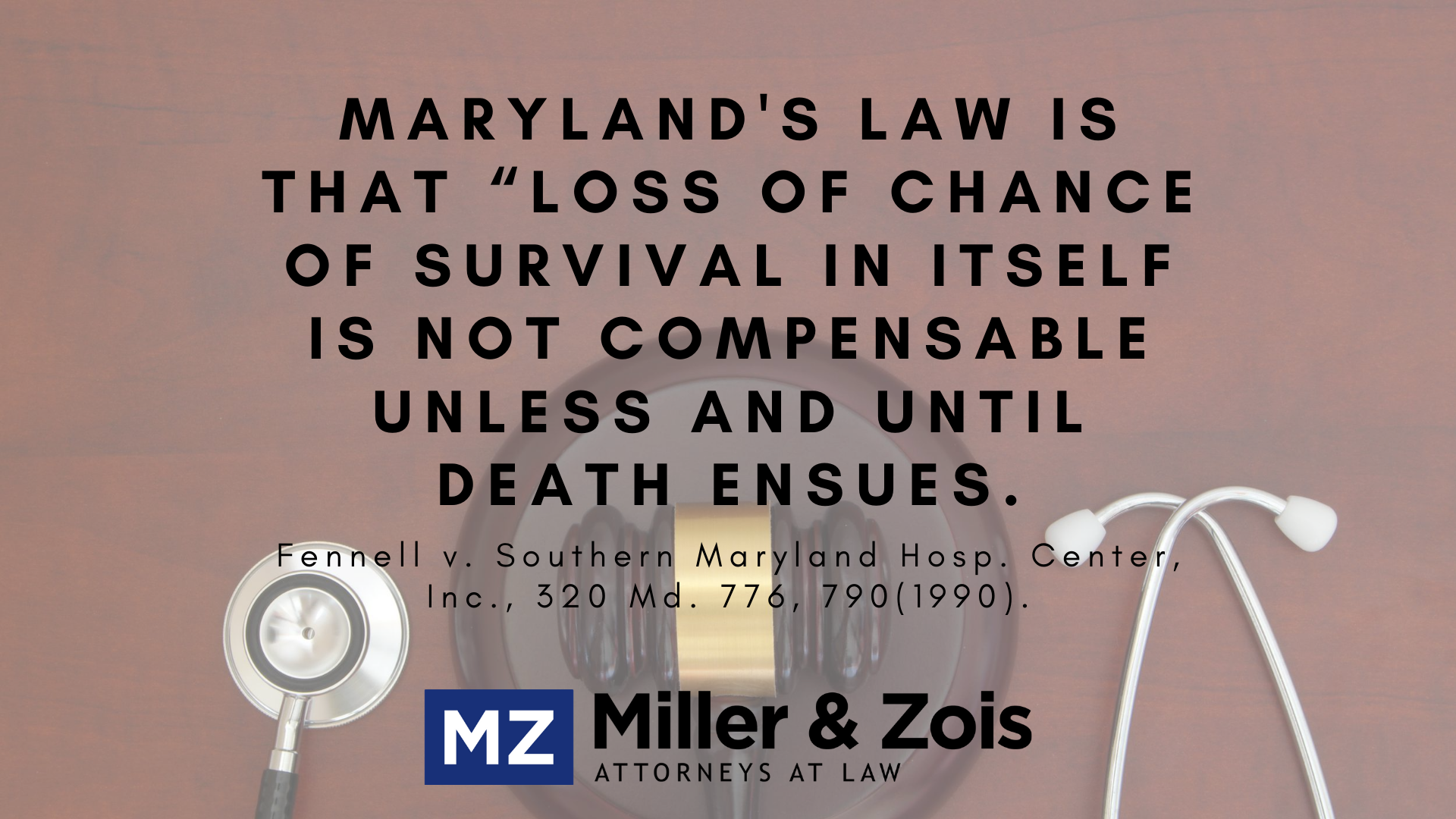The Michigan Supreme Court came out a few weeks ago with a very interesting opinion in favor of the Plaintiff in a malpractice claim that most likely would fail in Maryland.
The doctor’s malpractice attorneys argued that the allegation that the doctor’s negligence reduced the risk of stroke from 10 to 20 percent to less than 5 to 10 percent was not enough to get the claim to a jury because the loss did not meet the burden of proof on proximate causation. The  doctor argued that Michigan law is whether the opportunity to achieve a better result was greater than 50 percent. Under this law, if the plaintiff could not prove that receiving the alleged appropriate treatment would have decreased his risk of injury by 50%, the plaintiff’s claim would fail.
doctor argued that Michigan law is whether the opportunity to achieve a better result was greater than 50 percent. Under this law, if the plaintiff could not prove that receiving the alleged appropriate treatment would have decreased his risk of injury by 50%, the plaintiff’s claim would fail.
Thankfully, a divided Michigan high court found that this is not the law and that malpractice cases such as this should be decided under a simple principle: the plaintiff is required to prove that the doctor’s negligence more probably than not caused the plaintiff’s injury.
Regrettably, Maryland goes in a different direction on these types of cases as I have previously discussed. One thing Maryland has Michigan beat on is collegiality among the judges on the court. Battles in the Michigan Supreme Court are both political and personal in a way that would shock Maryland lawyers. Judges quoting political statements made by other judges to the press, the judge that wrote the majority opinion writing separately to refute one judge’s personal attack – if you have no interest in this issue it is worth reading the opinion just to get a taste of what this different world is like.
Maryland Loss of Chance Law
Instead of seeking damages for loss of chance, plaintiffs can argue that there is increased mental anguish in the fear of what might happen in the future. This differs from loss of chance. In Exxon v. Mobil Corp. v. Albright, which was decided in 2013 by the Maryland Court of Appeals, the court found that “recovery for damages for fear of cancer differs from the cause of action of a claim for enhanced or increased risk of disease. Fear of cancer is contemporaneous, but the risk of developing future disease necessitates speculation.” Accordingly, the Maryland high court found that victims may recover emotional distress damages for the fear of getting or exacerbating an illness or disease.
In 2016, in Luecke v. Suesse, this argument did not fly. The Court of Appeals honed in on the holding in Fennell v. Southern Maryland Hospital that “loss of chance of survival in itself is not compensable unless and until death ensues.” Fennell v. Southern Maryland Hospital. Center, 320 Md. 776, 790 (1990). The court specifically rejected the plaintiff’s effort to “rename” loss of chance.
Maryland’s Apolitical High Court
The Court of Appeals of Maryland blithely rolls along as a relatively apolitical body. Sure, there are conservative and liberal judges and they vote accordingly on some issues before the court but, it is just not a partisan-charged atmosphere. I think it helps that few issues before the Maryland high court are particularly politically-charged, as cases are before the Supreme Court. The average Marylander does not spend a lot of time thinking about what the Court of Appeals is doing. As we become more divided and more partisan as a society – which I think polls suggest that we are – I wonder if this will one day change and we will look back on 2010 as the glory days. (2020 Update: No, nothing has really changed in Maryland. Governors O’Malley and Hogan have done a good job picking judges. The Supreme Court, of course, has grown even more politicized.)
- Loss of Chance in Maryland (our law affirmed by the Court of Appeals)
- Mississippi toes this same ridiculous line on the loss of chance in January 2019
- Loss of Chance in Massachusetts
- Loss of Chance in the U.K.
Additional Loss of Chance Verdicts and Settlements
Here are some other loss of chance lawsuit stories and how a jury decided the case:
- 2018, Louisiana: $500,000 Verdict. The family of a four-month-old who tragically died alleged that three pediatric hospitalists failed to notice an infection that caused his death. The child was brought to the hospital where he received treatment for reflux aspiration that caused bronchitis. Nine days into his hospitalization, he underwent anti-reflux surgery. This involved the insertion of a gastronomy tube. He was discharged five days later. However, he returned to the hospital later that evening, suffering from a fever. His condition seemed to improve within a few days. However, they would discover a staph infection. Two days later, the boy was found dead. The battleground in this lawsuit was the cause of death. Plaintiff’s medical malpractice lawyers argued an infection around the gastronomy tube’s site caused septic shock. The hospitalists argued that it was only a small abscess. They claimed that he died of sudden infant death syndrome (SIDS). At trial, the plaintiff’s attorneys argued to the jury that the failure to order tests and cultures caused the failure to diagnose the boy’s infection. The hospitalists denied malpractice, arguing that they properly monitored him and administered antibiotics. They also argued that the blood culture tested negative. The jury returned a mixed verdict. They ruled in favor of the hospitalists for the wrongful death claim but ruled against the admitting hospitalist for the loss of chance. The jury determined that the loss of chance was at 30 percent. They determined the damages amounted to $500,000. The estate’s net award was $150,000. Does this verdict make sense? It does not. A 30 percent loss of chance for a child is worth what? It makes no sense unless this was a compromise verdict.
- 2018, Louisiana: $22,530 Verdict. A 50-something woman’s family and estate alleged that her treating physician’s delayed renal cancer diagnosis caused her death. The woman sought weight-loss treatment with the physician for several years. She eventually lost significant weight, but also suffered fatigue and anemia. Her physician failed to suspect renal cancer and thought her weight loss had positive effects on her health. The physician also consulted an oncologist who thought she had gastritis. Two years later, an MRI revealed a tumor. The woman would be diagnosed with renal cancer. Despite undergoing significant treatment, her cancer already metastasized to her lungs and lymph nodes. She died three years later. Before her death, she had already filed suit. The estate replaced her as the plaintiff after she died. They made both wrongful death and loss of chance claims. The estate alleged that cancer could have been treated if the physician diagnosed her earlier. After a four-day trial, the jury ruled in favor of the physician for the wrongful death claim but ruled in favor of the estate for the loss of chance. They found the oncologist 75 percent at fault, the treating physician 15 percent at fault, and the deceased 10 percent at fault. The jury determined the damages amounted to $22,350, which was reduced to a $3,379 net award.
- 2017, Washington: $8,000,000 Verdict. A 73-year-old woman alleged that her treating physician mismanaged her spinal cord decompression surgery, which resulted in permanent paralysis. Following the procedure, she suffered weakness in her left shoulder. A cervical spine MRI was interpreted to have shown fluid collection but revealed no spinal cord decompression that would have explained her shoulder weakness. The following day, her condition deteriorated significantly. She could not move her legs and experienced weakness in one of her arms. The woman was eventually diagnosed with a stroke and an epidural hematoma. She underwent surgery to remove the hematoma. However, she was rendered permanently paralyzed and could no longer stand or walk without a Hoyer lift. The woman could no longer walk without a walker. She also suffered reduced arm function. The woman experienced incontinence and now had a permanent catheter. She was now dependent on her husband for her daily living. The woman sued her physician, alleging that he delayed her hematoma diagnosis. This case involved a loss of chance claim. The jury determined that there was a 25 percent chance of a different outcome had she received an earlier diagnosis. They awarded $8,000,000, which would be reduced to $2,000,000.
- 2013, Massachusetts: $1,900,000 Verdict. A 53-year-old woman’s family alleged that her delayed breast cancer diagnosis caused it to metastasize and led to her death. She discovered a swollen lymph node, which her primary care physician confirmed. The woman also underwent follow-up imaging studies. Her physician then referred her to a surgeon for a biopsy. Her estate alleged that the surgeon told her to undergo additional imaging studies and to wait for the results before undergoing the biopsy. Over three months later, she sought the care of another surgeon, who performed a biopsy. She would be diagnosed with stage IV breast cancer. The woman underwent chemotherapy for over three years. However, she died 39 months after being diagnosed. Her estate sued the surgeon, the radiologist, and their employers. They made wrongful death and loss of chance claims. The defense counsel argued that the cancer was already at stage IV during her initial consultation. The estate alleged that the cancer had not metastasized and was curable. A jury ruled in favor of the radiologist for all counts and ruled in favor of the surgeon for the wrongful death count. However, they ruled in favor of the estate for the loss of chance. They determined that the deceased’s chance of survival within five years had dropped from 80 to 16 percent. The jury awarded $700,000 in pain and suffering and $400,000 each to the deceased’s husband and her two surviving daughters. The award would be reduced by 34 percent based on the loss of chance.
Note: this post was originally drafted in 2010 but update substantially in 2021.
 Maryland Injury Law Center
Maryland Injury Law Center


